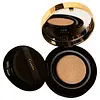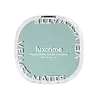What's inside
What's inside
 Key Ingredients
Key Ingredients

 Benefits
Benefits

 Concerns
Concerns

 Ingredients Side-by-side
Ingredients Side-by-side

Water
Skin ConditioningTitanium Dioxide
Cosmetic ColorantCyclopentasiloxane
Emollient2-Ethylhexylal
SolventEthyl Methoxycinnamate
UV AbsorberGlycerin
HumectantCyclohexasiloxane
EmollientCetyl Ethylhexanoate
EmollientCetyl PEG/PPG-10/1 Dimethicone
EmulsifyingPhenyl Trimethicone
Skin ConditioningEthylhexyl Salicylate
UV AbsorberPentylene Glycol
Skin ConditioningDimethicone
EmollientMethyl Methacrylate Crosspolymer
Zinc Oxide
Cosmetic ColorantSilica
AbrasivePEG-10
HumectantMagnesium Sulfate
Phenoxyethanol
PreservativeAluminum Hydroxide
EmollientDimethicone/Vinyl Dimethicone Crosspolymer
Skin ConditioningDisteardimonium Hectorite
StabilisingTrimethylsiloxysilicate
EmollientTriethoxycaprylylsilane
Betaine
HumectantStearic Acid
CleansingEthylhexylglycerin
Skin ConditioningParfum
MaskingDisodium EDTA
1,2-Hexanediol
Skin ConditioningBHT
AntioxidantAllantoin
Skin ConditioningCaffeine
Skin ConditioningCI 77492
Cosmetic ColorantCI 77491
Cosmetic ColorantCI 77499
Cosmetic ColorantWater, Titanium Dioxide, Cyclopentasiloxane, 2-Ethylhexylal, Ethyl Methoxycinnamate, Glycerin, Cyclohexasiloxane, Cetyl Ethylhexanoate, Cetyl PEG/PPG-10/1 Dimethicone, Phenyl Trimethicone, Ethylhexyl Salicylate, Pentylene Glycol, Dimethicone, Methyl Methacrylate Crosspolymer, Zinc Oxide, Silica, PEG-10, Magnesium Sulfate, Phenoxyethanol, Aluminum Hydroxide, Dimethicone/Vinyl Dimethicone Crosspolymer, Disteardimonium Hectorite, Trimethylsiloxysilicate, Triethoxycaprylylsilane, Betaine, Stearic Acid, Ethylhexylglycerin, Parfum, Disodium EDTA, 1,2-Hexanediol, BHT, Allantoin, Caffeine, CI 77492, CI 77491, CI 77499
Water
Skin ConditioningCI 77891
Cosmetic ColorantPolymethylsilsesquioxane
Ethylhexyl Methoxycinnamate
UV AbsorberCyclopentasiloxane
EmollientSilica
AbrasiveTrimethylsiloxysilicate
EmollientIsododecane
EmollientEthylhexyl Salicylate
UV AbsorberButylene Glycol
HumectantLauryl PEG-10 Tris(Trimethylsiloxy)Silylethyl Dimethicone
EmulsifyingNiacinamide
SmoothingButylene Glycol Dicaprylate/Dicaprate
EmollientPhenyl Trimethicone
Skin ConditioningPentylene Glycol
Skin ConditioningHdi/Trimethylol Hexyllactone Crosspolymer
Disteardimonium Hectorite
StabilisingC12-15 Alkyl Benzoate
AntimicrobialPEG-9 Polydimethylsiloxyethyl Dimethicone
EmulsifyingPEG-10 Dimethicone
Skin ConditioningMagnesium Sulfate
Phenoxyethanol
PreservativeTriethoxycaprylylsilane
Polypropylsilsesquioxane
Copernicia Cerifera Wax
Octyldodecanol
EmollientPolymethyl Methacrylate
Stearic Acid
CleansingAlumina
AbrasiveEthylhexylglycerin
Skin ConditioningPropylene Carbonate
SolventCeteareth-20
CleansingPolyglyceryl-4 Isostearate
EmulsifyingSteareth-100
Gel FormingDisodium EDTA
Isopropyl Titanium Triisostearate
EmollientCaprylyl Glycol
EmollientHexylene Glycol
EmulsifyingBHT
AntioxidantTocopherol
AntioxidantCaffeine
Skin ConditioningHydrogenated Lecithin
EmulsifyingCetearyl Alcohol
EmollientCeramide NP
Skin ConditioningCeramide Ns
Skin ConditioningCholesterol
EmollientPhytosphingosine
Skin ConditioningCeramide AP
Skin ConditioningCeramide As
Skin ConditioningCeramide EOP
Skin ConditioningWater, CI 77891, Polymethylsilsesquioxane, Ethylhexyl Methoxycinnamate, Cyclopentasiloxane, Silica, Trimethylsiloxysilicate, Isododecane, Ethylhexyl Salicylate, Butylene Glycol, Lauryl PEG-10 Tris(Trimethylsiloxy)Silylethyl Dimethicone, Niacinamide, Butylene Glycol Dicaprylate/Dicaprate, Phenyl Trimethicone, Pentylene Glycol, Hdi/Trimethylol Hexyllactone Crosspolymer, Disteardimonium Hectorite, C12-15 Alkyl Benzoate, PEG-9 Polydimethylsiloxyethyl Dimethicone, PEG-10 Dimethicone, Magnesium Sulfate, Phenoxyethanol, Triethoxycaprylylsilane, Polypropylsilsesquioxane, Copernicia Cerifera Wax, Octyldodecanol, Polymethyl Methacrylate, Stearic Acid, Alumina, Ethylhexylglycerin, Propylene Carbonate, Ceteareth-20, Polyglyceryl-4 Isostearate, Steareth-100, Disodium EDTA, Isopropyl Titanium Triisostearate, Caprylyl Glycol, Hexylene Glycol, BHT, Tocopherol, Caffeine, Hydrogenated Lecithin, Cetearyl Alcohol, Ceramide NP, Ceramide Ns, Cholesterol, Phytosphingosine, Ceramide AP, Ceramide As, Ceramide EOP
Ingredients Explained
These ingredients are found in both products.
Ingredients higher up in an ingredient list are typically present in a larger amount.
BHT is a synthetic antioxidant and preservative.
As an antioxidant, it helps your body fight off free-radicals. Free-radicals are molecules that may damage your skin cells.
As a preservative, it is used to stabilize products and prevent them from degrading. Specifically, BHT prevents degradation from oxidation.
The concerns related to BHT come from oral studies; this ingredient is currently allowed for use by both the FDA and EU.
However, it was recently restricted for use in the UK as of April 2024.
Learn more about BHTCaffeine is most associated with coffee, tea, and cacao. In skincare, it helps with calming inflammation and is rich in antioxidants.
While caffeine is used to treat cellulite and and dark circles, further studies are needed to prove this. It has been believed to help with these skin conditions due to its ability to dilate blood vessels and increase blood flow.
Some studies are looking into caffeine's ability to protect against UV rays.
Learn more about CaffeineCyclopentasiloxane, or D5, is a silicone used to improve texture of products and trap moisture.
D5 is considered lightweight and volatile. Volatile means it evaporates quickly after application. Once evaporated, D5 leaves a thin barrier that helps keep skin hydrated.
It is also an emollient. Emollients help soften the skin and prevent water loss. Silicones create a silky texture in products. D5 helps other ingredients become more spreadable.
Studies show D5 is safe to use in skincare products. We recommend speaking with a skincare professional if you have concerns.
Learn more about CyclopentasiloxaneDisodium EDTA plays a role in making products more stable by aiding other preservatives.
It is a chelating agent, meaning it neutralizes metal ions that may be found in a product.
Disodium EDTA is a salt of edetic acid and is found to be safe in cosmetic ingredients.
Learn more about Disodium EDTADisteardimonium Hectorite comes from the clay mineral named hectorite. It is used to add thickness to a product.
It can also help stabilize a product by helping to disperse other ingredients.
Hectorite is a rare, white clay mineral.
Learn more about Disteardimonium HectoriteEthylhexyl Salicylate is an organic compound used to block UV rays. It primarily absorbs UVB rays but offers a small amount of UVA protection as well.
Commonly found in sunscreens, Ethylhexyl Salicylate is created from salicylic acid and 2-ethylhexanol. You might know salicylic acid as the effective acne fighter ingredient and BHA.
The ethylhexanol in this ingredient is a fatty alcohol and helps hydrate your skin, similar to oils. It is an emollient, which means it traps moisture into the skin.
According to manufacturers, Ethylhexyl Salicylate absorbs UV wavelength of 295-315 nm, with a peak absorption at 307-310 nm. UVA rays are linked to long term skin damage, such as hyperpigmentation. UVB rays emit more energy and are capable of damaging our DNA. UVB rays cause sunburn.
Learn more about Ethylhexyl SalicylateEthylhexylglycerin (we can't pronounce this either) is commonly used as a preservative and skin softener. It is derived from glyceryl.
You might see Ethylhexylglycerin often paired with other preservatives such as phenoxyethanol. Ethylhexylglycerin has been found to increase the effectiveness of these other preservatives.
Magnesium Sulfate is a salt. More specifically, it is an epsom salt, or the bath salt used to help relieve muscle aches.
Despite having ‘sulfate’ in the name, it isn’t a surfactant or cleansing agent like sodium lauryl sulfate. Unlike those sulfates, magnesium sulfate doesn’t have the same cleansing or foaming properties (it's simply a type of salt).
In cosmetics, Magnesium Sulfate is used to thicken a product or help dilute other solids. It is a non-reactive and non-irritating ingredient.
One study shows magnesium deficiency may lead to inflammation of the skin. Applying magnesium topically may help reduce inflammation.
You can find this ingredient in sea water or mineral deposits.
Learn more about Magnesium SulfatePentylene glycol is typically used within a product to thicken it. It also adds a smooth, soft, and moisturizing feel to the product. It is naturally found in plants such as sugar beets.
The hydrophilic trait of Pentylene Glycol makes it a humectant. As a humectant, Pentylene Glycol helps draw moisture from the air to your skin. This can help keep your skin hydrated.
This property also makes Pentylene Glycol a great texture enhancer. It can also help thicken or stabilize a product.
Pentylene Glycol also acts as a mild preservative and helps to keep a product microbe-free.
Some people may experience mild eye and skin irritation from Pentylene Glycol. We always recommend speaking with a professional about using this ingredient in your routine.
Pentylene Glycol has a low molecular weight and is part of the 1,2-glycol family.
Learn more about Pentylene GlycolPhenoxyethanol is a preservative that has germicide, antimicrobial, and aromatic properties. Studies show that phenoxyethanol can prevent microbial growth. By itself, it has a scent that is similar to that of a rose.
It's often used in formulations along with Caprylyl Glycol to preserve the shelf life of products.
Phenyl Trimethicone is a silicon-based polymer. It is derived from silica.
Phenyl Trimethicone is used as an emollient and prevents products from foaming.
As an emollient, it helps trap moisture in the skin. It is considered an occlusive.
Learn more about Phenyl TrimethiconeSilica, also known as silicon dioxide, is a naturally occurring mineral. It is used as a fine, spherical, and porous powder in cosmetics.
Though it has exfoliant properties, the function of silica varies depending on the product.
The unique structure of silica enhances the spreadability and adds smoothness, making it a great texture enhancer.
It is also used as an active carrier, emulsifier, and mattifier due to its ability to absorb excess oil.
In some products, tiny microneedles called spicules are made from silica or hydrolyzed sponge. When you rub them in, they lightly polish away dead skin layers and enhance the penetration of active ingredients.
Learn more about SilicaStearic Acid is a fatty acid. It is an emollient, emulsifier, and texture enhancer.
As an emollient, stearic acid helps soften skin. It aids the skin's protective barrier by preventing water loss. It also provides a gentle cleansing effect without stripping away natural oils.
Stearic acid may also be used to enhance the texture of products. It can add volume and stabilize ingredients such as water and oil. This can help water and oil ingredients from separating.
Sources of stearic acid include animal or vegetable fats/oils such as coconut or shea. It can be naturally found in butter, cocoa butter, shea butter, vegetable fats, and animal tallow.
This ingredient may not be Malassezia folliculitis, or fungal-acne safe.
Learn more about Stearic AcidTriethoxycaprylylsilane is a silicone used to bind and stabilize ingredients.
As an emulsifier, it helps prevent ingredients from separating. This can help elongate the shelf life of products.
Triethoxycaprylylsilane is often used to coat mineral sunscreens ingredients to help give a better feel. It also helps reduce oxidative stress in sunscreens.
Learn more about TriethoxycaprylylsilaneThis silicone is an emollient. Emollients create a thin film on the skin to prevent moisture from escaping.
It is not soluble in water and helps increase water-resistance in products.
According to a manufacturer, it can blend seamlessly with silicone oils, such as Cyclopentasiloxane.
Learn more about TrimethylsiloxysilicateWater. It's the most common cosmetic ingredient of all. You'll usually see it at the top of ingredient lists, meaning that it makes up the largest part of the product.
So why is it so popular? Water most often acts as a solvent - this means that it helps dissolve other ingredients into the formulation.
You'll also recognize water as that liquid we all need to stay alive. If you see this, drink a glass of water. Stay hydrated!
Learn more about Water